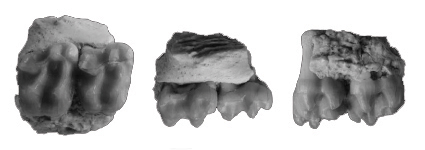| Location: Home > Research > Research Progress |
| Early Eocene perissodactyls (mammalia) from the Upper Nomogen Formation of the Erlian Basin, Nei Mongol, China |
|
Dr. Wang Yuanqing, Institute of Vertebrate Paleontology and Paleoanthropology, Chinese Academy of Sciences, and his research team, recently described a new specie of the lophialetid tapiroid, Minchenoletes erlianensis gen. et sp. nov., and the hyracodontid rhinocerotoid Pataecops parvus, from the upper part of the Nomogen Formation of the Erlian Basin, Nei Mongol, China, as reported in the 1st issue, volume 49 (2011) of Vertebrata PalAsiatica. Perissodactyls are an ordinal group of mammals first appeared at the earliest Eocene in the Holarctica. Taxa of this age are critical in understanding of the origin and early radiation of the group, although most of them are represented by fragmentary materials. Some major lineages of perissodactyls have been documented in the earliest Eocene in Asia. Materials mentioned were from the upper part of the Nomogen Formation (Bumbanian, Early Eocene) in the Huheboerhe area of Nei Mongol (Inner Mongolia), China. Newly found specimens of perissodactyls from the upper part of the Nomogen Formation represented two species: the lophialetid tapiroid Minchenoletes erlianensis gen. et sp. nov. and the hyracodontid rhinocerotoid Pataecops parvus. M. erlianensis differs from the known lophialetids in having smaller size, lower crowned cheek teeth, less developed lophs, smaller length/width ratio in M1–2, and proportionally longer M3. Both taxa extend the fossil records of the Lophialetidae and the Rhinocerotoidea to the earliest Eocene. They extended the fossil record of both the Lophialetidae and the Rhinocerotoidea to the earliest Eocene. “Recent stratigraphic data shows that Minchenoletes is only found from the upper part of the Nomogen Formation (Bumbanian), while Schlosseria and Lophialetes occurred respectively in the Arshanto and the Irdin Manha formations, enhancing their significance in biostratigraphic correlations and understanding of early evolution of perissodactyls,” Said Dr. Wang. “Based on the new stratigraphic data and review of the fieldnote of the CAE we consider that the Mongolian specimens of Pataecops parvus probably came from a lower stratigraphic level than most taxa of the Kholobolchi fauna, possibly correlative to the Bumbanian age.” This study was supported by the National Basic Research Program of China (Grant No. 2006CB806400), the Chinese Academy of Sciences (Grant No. KZCX2−EW−106), the Basic Work Program of MST of China (Grant No. 2006FY120300-15), the National Natural Science Foundation of China (Grant No. 40532010), Special Fund for Fossil Excavation and Preparation of Chinese Academy of Sciences, and US National Science Foundation (Grant No. EAR-0120727, BCS-0309800, BCS-0820602).
Holotype of Minchenoletes erlianensis, right maxilla with M1-2 (courtesy of Dr. Wang)
Pataecops parvus, left maxilla with P3-M3 (courtesy of Dr. Wang) |

